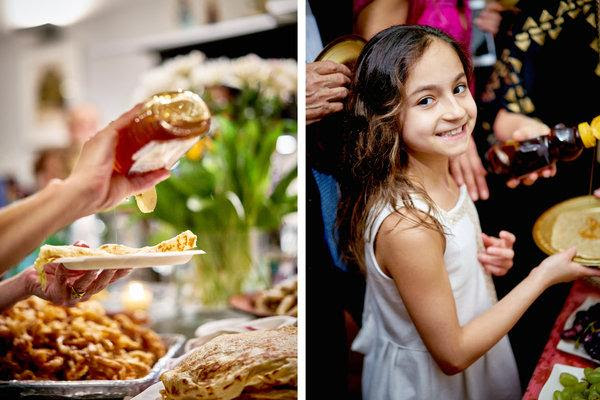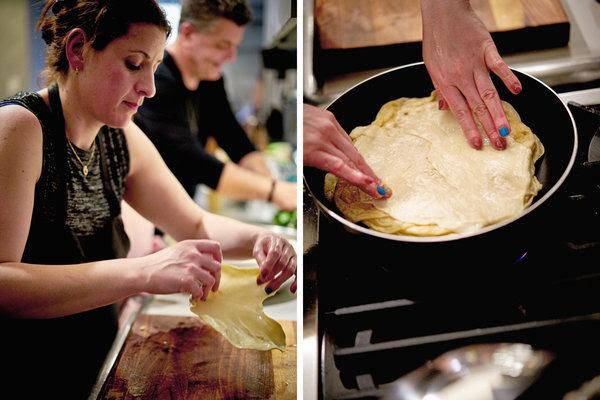The New York Times
By Ron Lieber
A spread of Moroccan cookies from a Mimouna celebration last year in New York. Because flour is not allowed in the house during Passover, other ingredients are used, like coconut, pistachios, dates and various nuts. Meringues and homemade marzipan are also often on offer.
Credit Francesco Sapienza for The New York Times
This Moroccan ritual, now widely popular in Israel but little known in America, offers a spread of sweets including a stacked cake called moufleta.
For American Jews who can’t go too long without their favorite carbohydrates, the end of Passover offers nearly as much cause for celebration as the holiday itself. Many begin right at sundown, wolfing down pizzas. Then come the brownies or other foods with the leavening ingredients they have been avoiding in a nod to ancestors who had no time to let bread dough rise while fleeing Egypt.
Unbeknown to many Americans, however, Moroccan Jews have long marked the end of Passover with a more established ritual, a raucous tradition known as Mimouna. Soon after sunset on the last night of the holiday (observed this year on Friday or Saturday), they indulge in the first leavened food since Passover began: moufleta, a pan-cooked cake smeared with butter and honey.
A variety of other Moroccan sweets follow, on a long, elaborately decorated table that includes the requisite mint tea. For Jews in Israel, where many Moroccans immigrated in the decades after its founding in 1948, Mimouna is now practically a national holiday, as Jews of all backgrounds break the bread that has been temporarily forbidden.
From left, moufleta served with honey, and enjoyed by a young party goer, Mia Gavrielov. Credit Francesco Sapienza for The New York Times
It isn’t easy to find a Mimouna in America. I spent years trying to invite myself to one before finally attending two last year, in Manhattan and Brooklyn. But you can make your own and make it your own, as long as it includes moufleta.
The origins of Mimouna, which seem to go back at least 200 years, are murky, and the word lends itself to many interpretations. There is a similar Hebrew word that means faith, and an Arabic one that connotes good fortune or luck. An etymological connection to the Jewish philosopher Maimonides is also possible, as is one to the name of a Berber goddess.
Setting a traditional Mimouna table begins with foods you lay out as symbols but do not actually eat. A live fish in a bowl connotes fertility or abundance. Milk, eggs, wheat, fava beans and flour may make an appearance, too.
You have 4 free articles remaining.
Subscribe to The Times
There are also foods that do not show up on the table. Observant Jews do not mix meat and milk (and thus the butter that tops the moufleta) in the same meal, so this is not the time to show off your lamb tagine skills. Nor do traditionalists bake cookies with flour; that would require having bags of flour or Mimouna cookies in the house during Passover, which is also against the rules.
Rebecca Alcobi, who lives in Israel, celebrating her first Mimouna in the United States.
Credit Francesco Sapienza for The New York Times
Instead, a Mimouna table may contain marzipan or cookies and other sweets made only with nuts. Candied eggplant sometimes appears, and it is better than you might think.
And then there is moufleta. A flat cake a bit like chapati, it cooks up quickly from a dough that Mimouna hosts can throw together after the sun sets. In Morocco, non-Jewish neighbors often bring flour to their hosts at the appointed hour.
At my first stop last year, in the Williamsburg section of Brooklyn, much fun was made of the fact that Yuki Levinson, an Israeli-American with Ashkenazi (European) roots, was at the stove. Though she is the proprietor of a Brooklyn catering business called Yuki’s Cookies and learned to make moufleta at the side of an elderly Moroccan woman, the crowd of guests, many of them Israelis descended from North African families, were still slightly suspicious.
Head down, Ms. Levinson stood at the stove with the makings of many dozen moufleta, and proceeded to prove herself. Her training? As a cook in a secret Israeli Army unit that she would not describe. The pan? “I bought it at the 99-cent store in Midwood,” she said.
Yuki Levinson, a pastry chef who owns Yuki’s Cookies in Brooklyn, making moufleta. Credit Francesco Sapienza for The New York Times
She rolled out the first moufleta with the help of an assistant, dropped it into the pan, flipped it once and then put the next on top. The heat from the first moufleta began cooking the side of the second that touched it, and then she flipped both at once, so the second moufleta got a browning on one side. She repeated this, over and over, until she had a stack of dozens, flipping the growing stack with her fingers.
“When you work in a kitchen, you don’t really feel the heat anymore,” she said.
As the pile became nearly unmanageable, the guests began hovering. The hosts laid out softened sticks of butter and squeeze bottles of honey, near an enormous tea set with a kaleidoscopic array of colored glasses.
When the guests dug in, one thing became immediately clear: Mimouna has to be in the running for the stickiest culinary ritual known to humanity. Honey gets under your fingernails, on your lapel, in the crevices of your cellphone and on the bottom of your shoes as children mill about and dribble it on the floor. So you rinse, and repeat.
In Moroccan communities in Israel, there are generally no formal invitations to Mimouna, but everyone comes. Hosts maintain an open-door policy, and families wander from house to house, sipping tea, eating a moufleta, sampling another sweet or two and then walking down the street for more.
A variety of sweets at a Mimouna celebration in Manhattan last year, including citron (etrog) confiture, strawberry confiture, pomelo peel jam and whole orange cooked with syrup and cinnamon sticks. All were prepared by Meirav Alcobi Gavrielov and her mother, Rebecca Alcobi. Credit Francesco Sapienza for The New York Times
To the slight chagrin of certain traditionalists, Mimouna is a bit of a political event as well. Like his predecessors, the Israeli prime minister, Benjamin Netanyahu, makes requisite appearances and gets honey on his fingers.
Shira Ohayon, a researcher of Middle Eastern Jewish and feminist culture in Israel who was born to Moroccan Jews, has a relative who is active in Israeli politics. “He makes a big Mimouna,” she said. “All the ministers would come. It’s more of an industrial Mimouna.”
Around 10 one night last April, Sidney Cohen wandered into a decidedly nonindustrial Mimouna at the home of Meirav Alcobi Gavrielov and Varan Gavrielov on the Upper East Side of Manhattan. Moufleta cooked by Rebecca Alcobi, Ms. Alcobi Gavrielov’s mother, who had never celebrated Mimouna in America, emerged from a small galley kitchen.
“By this time in Israel, you would have been to seven or eight houses, and you wouldn’t have even seen the owners, because they were at other people’s houses,” Mr. Cohen said, pausing to lick his fingers.
“Now, I need tea,” he added. “Where is the tea?” And he headed back to the buffet to wash everything down.
Recipes: Moroccan Moufleta | Baked Coconut Balls












